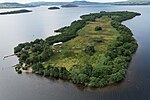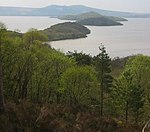Balmaha
Loch LomondStirling (council area) geography stubsVillages in Stirling (council area)

Balmaha (Gaelic: Baile Mo Thatha) is a village on the eastern shore of Loch Lomond in the council area of Stirling, Scotland. The village is a popular tourist destination for picnickers and day trippers from Glasgow as well as walkers on the West Highland Way. The only road passing through the village is the B837. Boat trips leave from Balmaha for the town of Balloch and the village of Luss as well as nearby Inchcailloch Island.Balmaha sits at the westerly foot of Conic Hill, and is roughly 30 kilometres (20 miles) along the West Highland Way if coming from Milngavie.
Excerpt from the Wikipedia article Balmaha (License: CC BY-SA 3.0, Authors, Images).Balmaha
B837,
Geographical coordinates (GPS) Address Phone number Nearby Places Show on map
Geographical coordinates (GPS)
| Latitude | Longitude |
|---|---|
| N 56.084 ° | E -4.54 ° |
Address
The Oak Tree Inn
B837
G63 0JQ
Scotland, United Kingdom
Open on Google Maps









